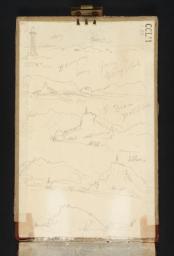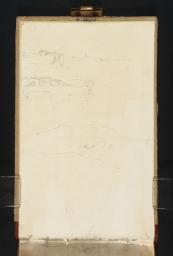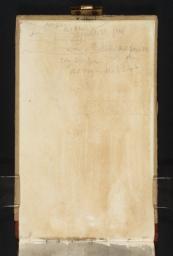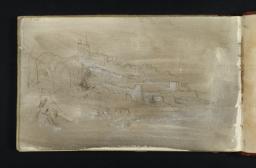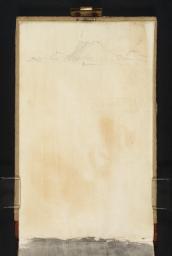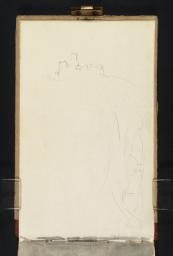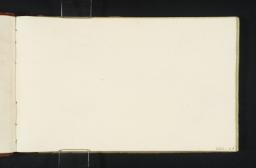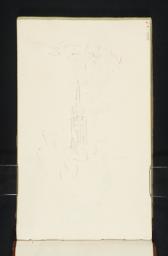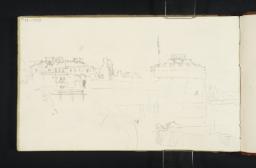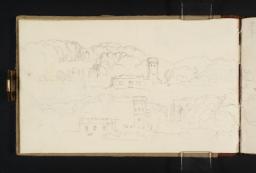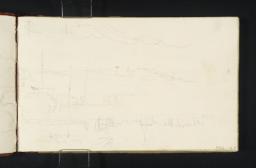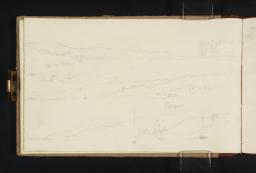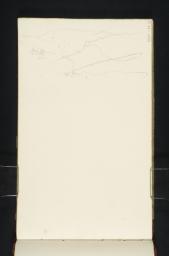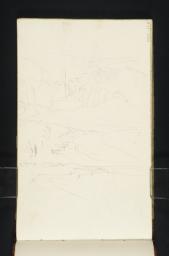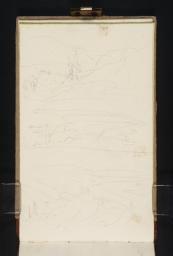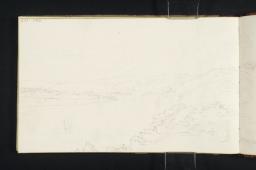Turner Bequest CCLII 1–92
Sketchbook bound in boards, quarter bound in buff paper with brown leather spine and a brass clasp
92 leaves and pastedowns of white wove paper, with edges washed green; various sheets watermarked ‘J. JELLYMAN | 1828’; page size 114 x 187 mm
Made by Joseph Jellyman of Downton Mill, Wiltshire
Inscribed in partially erased black ink ‘GURNSEY’ [sic] on spine
Numbered 289 as part of the Turner Schedule in 1854 and endorsed by the Executors of the Turner Bequest in ink on front cover (see Technical notes)
Inscribed in pencil ‘CCLII’ front cover, towards top left
Stamped in black ‘CCLII’ front cover top right
Blind-stamped with the Turner Bequest monogram on leather part of front cover, towards top left and front cover, centre
92 leaves and pastedowns of white wove paper, with edges washed green; various sheets watermarked ‘J. JELLYMAN | 1828’; page size 114 x 187 mm
Made by Joseph Jellyman of Downton Mill, Wiltshire
Inscribed in partially erased black ink ‘GURNSEY’ [sic] on spine
Numbered 289 as part of the Turner Schedule in 1854 and endorsed by the Executors of the Turner Bequest in ink on front cover (see Technical notes)
Inscribed in pencil ‘CCLII’ front cover, towards top left
Stamped in black ‘CCLII’ front cover top right
Blind-stamped with the Turner Bequest monogram on leather part of front cover, towards top left and front cover, centre
Accepted by the nation as part of the Turner Bequest 1856
Exhibition history
References
This pocket-sized sketchbook features pencil drawings taken at three main locations: the Channel Islands, Southampton, and the Normandy banks of the Seine between Le Havre and Caudebec-en-Caux. Views of these disparate places recur throughout the volume without evident pattern although, broadly speaking, the French and English subjects are grouped towards the beginning (as presently foliated), while the scenes taken on and around the Channel Islands of Guernsey, Sark, and Alderney feature in the later pages. There is no evidence to suggest that the volume has been altered, so its ‘erratic, unsystematic sequence’ of subjects and locations indicate that Turner used it in an ad hoc manner during the course of his travels.1 In fact, it is not unusual for pages to include views from several different locations. See, for example, the opposing folios 28 verso (D23573; Turner Bequest CCLII 28a) and 29 recto (D23574; Turner Bequest CCLII 29) which feature vistas of St Sampson Bay on Guernsey and, in Hampshire, Southampton and Netley Castle. Several pages were prepared with a grey wash to be worked up in pencil and heightened with white as in folio 3 recto (D23529; Turner Bequest CCLII 3), although the majority of these were left blank in the event.
The exact dating of the tour, or tours, recorded in this sketchbook is not fully established, although the drawings must certainly post-date the paper’s 1828 watermark (see Technical notes). Its present grouping with the Seine and Paris and Paris and Environs sketchbooks (Tate; Turner Bequest CCLIV, CCLVII), which are known to have been taken on the 1832 journey up the Seine is based upon the circumstantial, if multiple, sources of evidence collected by art historian Ian Warrell. Several of the Seine sketches appear to have contributed to engravings cut by the autumn of 1833, so it is assumed that the latest possible date for the drawings’ execution is at some point late in 1832.2 Of the three known French journeys that Turner undertook in this timeframe, Warrell favours a connection to the 1832 trip for reasons associated with the Guernsey section of the book. Firstly, the name Turner appears on the list of ferry passengers newly arrived on the island on Wednesday 22 August of that year.3 Secondly, the artist would later refer to the ‘unfortunate’ nature of his stay in Guernsey, perhaps in reference to the arrival of the European cholera epidemic on the island on that very day.4 Furthermore, the inside back cover of the volume (D41076) is inscribed with a cure for one of cholera’s principal symptoms – diarrhoea – at a time when Turner was actively seeking remedies for that disease.5 However, although art historian Andrew Wilton and Warrell have each proposed speculative itineraries linking the sketchbook’s locations into a single journey,6 the possibility remains that Turner carried this volume with him on separate trips, rendering a dating based on both the Guernsey and Seine sections problematic.
Nevertheless, as outlined in the general Introduction to the 1832 tour, it is certainly the case that Turner was much occupied with gathering material for engraved reproductions around this time, and that many of the Normandy subjects studies in this sketchbook were worked up into contemporary watercolour compositions for precisely that purpose.7 Thus the terrain and architecture of Cap de la Hève, Le Havre, Tancarville, Quillebeuf, Lillebonne, and Caudebec-en-Caux featured prominently in engravings for the 1834 volume of Turner’s Annual Tour: Wanderings by the Loire and Seine (1833–5; later reissued as Rivers of France); see Tate impressions T04699, T05593–T05601.
The impetus for the trip to the Channel Islands appears to have been more speculative in nature. Given Turner’s abiding interest in marine subjects, the promise of picturesque cliffs and densely fortified coastlines presumably exerted a considerable pull on an artist always in pursuit of fresh material.8 On Guernsey, the medieval fortresses of Castle Cornet and Vale Castle, the built-up hills around St Peter Port, and the heavily defended bays of St Sampson, Petit Bot, and Rocquaine, are objects of particular scrutiny in these pages. At Sark, the emphasis is upon the island’s high, jagged cliffs, the rocky little harbour of Creux, and, above all, the perilously narrow isthmus – La Coupée – which join Little Sark to the main island. Alderney Island and the nearby reefs known as The Caskets are recurrent throughout the later sketched passages. For each of the more frequently recurring sites, a key entry is selected in which further drawings are listed:
Alderney: The Caskets (folio 90 recto; D23693; Turner Bequest CCLII 90)
Guernsey was serviced by regular steamer ferries to Southampton,9 the harbour and neighbourhood of which form the third major subject of the volume. From across the Solent, Turner recorded several views of the port area, identifiable by the two needle-like spires of St Mary’s and St Michael’s Churches; see folios 27 verso to 28 verso (D23571–D23573; Turner Bequest CCLII 27a– 28a); 45 verso (D23604; Turner Bequest CCLII 45a); 46 recto (D23605; Turner Bequest CCLII 46); 47 recto (D23607; Turner Bequest CCLII 47); 65 verso (D23644; Turner Bequest CCLII 65a). Turner had first committed studies of the nearby ruins of Netley Abbey to paper back in 1795; this sketchbook contains a longer sequence of studies; see folio 32 verso (D23581; Turner Bequest; CCLII 32a) for the key entry on this subject.
Ibid., p.36; Martin Butlin, Andrew Wilton and John Gage, Turner 1775–1851, exhibition catalogue, Royal Academy, London 1974, p.114.
Technical notes
How to cite
John Chu, ‘Guernsey Sketchbook ?1832’, sketchbook, April 2014, in David Blayney Brown (ed.), J.M.W. Turner: Sketchbooks, Drawings and Watercolours, Tate Research Publication, April 2015, https://www

